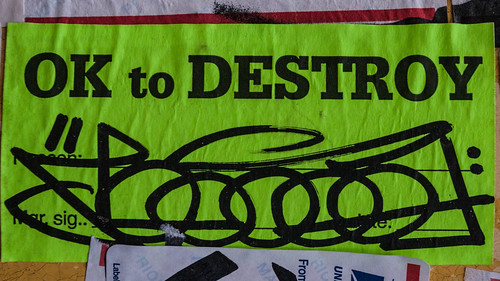Here’s a triple, a trifecta, a trinity, from Charlie Keil. It’s about a Global Organization of Democracies (GOOD). Let him explain it.
An Open Letter to Citizens of the World
Dear Citizen:
I think we need a common GOOD, a Global Organization Of Democracies, one nation one vote, (so that a confederation of indigenous peoples up the Amazon can have the same voting power as the USA, Okinawa the same vote power as Japan, etc.) [big so-called democracies may not want to be members at first], to be meeting year round to suggest ways of: stopping "ethnic cleansing" and "administrative massacres," terrorism, and wars; sharing air, water and resources fairly; raising global carbon taxes for local carbon sequestration (planting trees, fostering permacultures) going strong everywhere; planning and fostering a global literacy campaign focused on young women, etc., etc.
For every real problem you can think of, the world needs to hear these discussions, suggestions, planning sessions year round so that hopes can realistically be raised about stopping climate destruction, reducing global storming, etc. Can you give these "self-determination of peoples" and "conserving the speciation" ideas 8 minutes a day? 12 minutes a day on Saturday and Sunday?
Peace is the Way! (to ecological balance)
Charlie Keil
For the common GOOD
To stop the ecocatastrophe and build world peace processes a Global Organization of Democracies (GOOD) supporting the International Criminal Court (ICC) could coordinate efficient regional police forces to help prevent "administrative massacres" and terrorism, thereby enhancing the security of all peoples and encouraging states to redirect a growing portion of their military budgets to economically sustainable problem-solving over time.
The existence of a Global Organization Of Democracies whose representatives meet regularly to instruct a reform caucus at the UN and to mobilize regional police in pursuit of justice as defined by the arrest warrants and subpoenas of the new International Criminal Court, might make possible five important processes:
1) a continuing effort to intervene diplomatically, economically, politically, and to make arrests, if necessary, whenever the International Criminal Court determines that the "cleansings" or "administrative massacres" which lead to genocide are in the planning and/or early execution stages;
2) the pursuit and arrest of individuals and small groups of terrorists, as identified and located by international intelligence, for the International Criminal Court;
3) a continuing effort to halt the invention and proliferation of weapons of mass destruction, so many of which are ever more easily delivered by a single person;
4) a rapid disarmament process in all the nations of the world that would release billions of dollars, euros, yuan, yen, rubles, francs, pounds, kroner, pesos, etc; for
5) solving the world’s most pressing problems - climate change, ozone layer depletion, top soil erosion, AIDS, illiteracy, overpopulation, famine, landmines, etc. - that currently are the root causes of civil unrest, wars, more terrorism, insecurity, etc.
Without small, professional but unarmed police teams in each region of the world that are capable of making arrests, giving safe haven to witnesses, backing up the diplomacy of democratic nations supporting the international courts, there is no reasonable alternative to unjust and unwinable wars that destroy people, resources, Nature and the speciation we depend upon for our very survival.
A Race to the Top: the Common G.O.O.D as a Race to Achieve Ecological Balance
With the US corpstate escalating drone warfare to the level of mass-murder (when 100s of innocent victims become thousands) and hardly anyone protesting these ongoing "administrative massacres," with China and Russia blocking UN resolutions month after month, year in year out, that might bring aid to the people attempting to overthrow the murderous Assad dictatorship in Syria, it is hard to imagine a friendly competition in which nations all over the world compete to see who has:
- the highest carbon taxes,
- the largest percentage of land devoted to true (no humans) wilderness,
- the greatest number of trees planted per year per capita,
- the smallest standing army,
- the best approach to peace,
- the fewest number of citizens incarcerated per 100,000,
- the fewest youth murders and youth suicides per year,
- the highest percentage of vegetarians,
- the best health system at lowest cost per capita,
- the best quality-of-life expectancies,
- the lowest infant mortality rate,
- the lowest birth rate,
- the fewest number of citizens "under surveillance,"
- the best child care centers as measured by 8 very different sets of creativity criteria,
- the smallest annual income gaps between CEOs and average workers,
- and so on and so forth.
Which country on Earth is doing the best to nurture Nature rather than destroy Her? Who is second, and trying hardest to slow the extinction of species and maximize the diversity of cultures within it's borders? What are those 8 or a dozen language-neutral sets of creativity criteria that can be applied to child care centers around the world? What are the criteria for best ecological practices and most imaginative approaches to world peace?
A Global Organization Of Democracies (G.O.O.D.) meeting five days a week 50 weeks a year --one nation, one official delegate, one vote -- might quickly find itself giving Quality of Life awards each year in 50 different categories to its member states for meritorious service to a state's citizen constituents and another list of awards to small democracies that have given notable services and contributions to states that are struggling to become democracies capable of joining the common GOOD. This seems quite possible to me: A "race to ecological balance" with many dimensions, each dimension a component of achieving a world where limited resources are fairly distributed, quality of life is measured and growing, people can count on good behavior winning praise and prestige as well as making world peace and a broad but limited prosperity possible.
We reached a point somewhere in the previous century where huge human populations leveraged by an exploding technological destruction of the planet started to reduce the Earth's carrying capacity for life forms very dramatically. Now our weather is changing for the worse, and an estimated 200 species go extinct each day. The Holocene extinction that began 50 thousand years ago with man's wiping out most of the megafauna on all continents over a 40,000 year period, is now accelerating! It takes about 10 million years for the speciation to fully recover after a 50 to 90% extinction of species like the one our best scientists are saying is upon us. Once upon a time the planet probably lost just a few species each year. Now we lose at least one or two each hour.
To survive, we have to stop burning fossil fuels. We have to stop using cars and planes. Is anyone traveling by solar powered blimp yet? We need a total transformation to "appropriate" and "sustainable" technology ASAP. Big money prizes for Nature-friendly scientific and technological breakthroughs in the direction of 'less is more.' A moratorium on genetically modified organisms. I feel a very long list coming on. . . . . . But what's the point if there is no Global Organization Of Democracies meeting daily to discuss these issues, plan accordingly, make suggestions, reach agreements, set realistic goals?




















